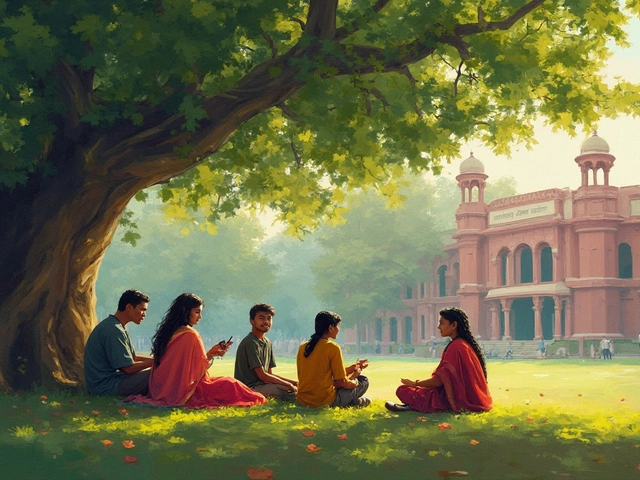Picture a teenager trying to crack the most competitive exam in India, burning the midnight oil for two, maybe even three years, all for a shot at the Indian Institutes of Technology (IITs). Now imagine another student working toward the dream of Harvard, with a whole package of extracurriculars, essays, and near-perfect academics. Which one’s got it worse? Regular debates fire up in classrooms and coffee shops across India: “Is IIT tougher than Harvard, or is it the other way round?” To really answer this, let’s pull back the curtain—numbers, daily life, and downright brutal admissions with no sugarcoating.
The Admissions Maze: IIT vs Harvard Entry Barriers
No point side-stepping the obvious: getting a spot at either IIT or Harvard is a jaw-dropping achievement. But the method to madness couldn’t be more different. In India, The IIT Joint Entrance Examination (JEE Advanced) is infamous—it’s been called a “brain massacre” by exhausted teenagers all over the country. In 2024, close to 1.2 million students attempted the first stage (JEE Main). About 250,000 were allowed for JEE Advanced, but only around 17,400 made it to an IIT seat at undegraduate level. Do the math—that’s an acceptance rate of roughly 1.4%!
Meanwhile, Harvard’s selectivity is legendary in its own way. In 2024, out of nearly 57,000 applicants, about 2,000 got the nod: a 3.5% acceptance rate. That’s cutthroat, sure, but twice as high as IIT’s.
But there’s a twist. The JEE Advanced tests sheer problem-solving skills in maths, physics, and chemistry. For many, it’s like trying to solve three Rubik’s cubes at once, underwater. No marks for charm, sports, or that time you played the lead in your school musical. Harvard, on the other hand, loves the “well-rounded” kid—those stacked with stories, leadership, and community action, with top-notch SAT/ACT scores and killer essays. It’s a basket of talents, not just one metric.
| University | No. of Applicants (2024) | No. of Accepted | Acceptance Rate |
|---|---|---|---|
| IIT (JEE Advanced) | 250,000 (Stage 2) | 17,400 | ~1.4% |
| Harvard | 57,000 | 2,000 | ~3.5% |
So, if you want one clear, *numbers only* answer—getting into top IITs is even harder, statistically. But don’t get cocky yet. Harvard wants a lifetime’s portfolio, not just three years at the study table. And both roads are exhausting, just in different ways.
Inside the Pressure Cooker: Academic Rigor at Both Institutions
Okay, you’re in. Now comes the real slog. Folks expect IITians to be “machines.” That’s only half-joking. Freshers get a reality check almost overnight. Syllabus moves at supersonic speed. First-year attrition is no joke—some estimates suggest 5% of students struggle to keep up, and mental health clinics on campus are busier than ever. Professors aren’t shy about tough love either. Assignments come thick and fast, and if you’re the kind who thinks ‘late submission’ is cool, you might as well pack up early.
JEE might be the highest mountain, but the trek doesn’t end at the summit. You’ll meet people who literally breathe equations and hack code in their sleep. It’s common for students who topped school for twelve years to find themselves barely scraping an average in IIT. The competition can be so stifling, some even say “it’s like going from being a big fish to the smallest guppy in a tank of sharks.”
Harvard’s academic intensity comes with a different flavor. There, the pace can seem just as relentless, but it’s not only about test grades. Participation, essays, projects, and group work count. Harvard expects deep thinking, not just memorization or quick math. Students slog over essays that might make an Ivy League admissions officer weep with joy or boredom. There’s less rote, but demands for originality are sky-high. One notorious Harvard stat: the infamous “grade inflation.” A whopping 60% of students reportedly score an A or A-minus. But don’t be fooled—that’s partly because every kid there is a perfectionist, and the pressure to not be the odd one out is crushing in its own sneaky way.
Sure, there are differences in how each campus handles stress. IIT campuses have seen efforts to ramp up counseling and student support, but stigma around mental health is still pretty strong. At Harvard, long lines at the wellness center are common, and “imposter syndrome” is almost a rite of passage. Don’t underestimate the anxiety—being surrounded by prodigies can make anyone doubt themselves. Both campuses force you to reinvent yourself, or risk sinking fast.

Life Beyond the Books: Campus, Culture, and Daily Grind
IIT’s campus life is famous for its rawness and no-frills environment. Hostels are basic but functional—you will learn to live with cold showers, leaky faucets, and the mammoth task of laundry. The mess food becomes both a running joke and a reason for instant nostalgia. Yet, there’s a wild freedom on these sprawling campuses. Cultural festivals like IIT Bombay’s Mood Indigo or IIT Madras’ Saarang can put Bollywood parties to shame. Clubs are everywhere—coding, robotics, music, sports, and “geek-culture” meetups are the heartbeats of every dorm. Friendships are intense—fueled by the stress of the endless grind and those hilarious 3 a.m. samosa runs.
But nobody will pamper you. Want something done? DIY, or queue up and hope for the best. Seniors become guides, pranksters, and at times, second family. Ragging (old-school hazing) has been curbed by strict rules, but informal indoctrination into campus culture is still alive in clever (mostly harmless) forms. The one thing every IITian carries away? Resilience and “jugaad”—that uniquely Indian way of fixing impossible problems with whatever’s at hand.
Harvard swings in the other direction. There’s history and prestige in every corner—libraries that seem straight out of movies, grassy courtyards, and the faint smell of hundreds of years of tradition. Dining halls serve food that won’t make you crave home-cooked meals (that much). There’s funding for nearly any club you can dream up, from Quidditch to quantum finance. Social life is just as jam-packed, but presentations, mixers, and interviews crowd out most lazy afternoons. Dorms might look charming, but roommates from wildly different backgrounds mean instant lessons in negotiation.
There’s also more institutional support at Harvard—career coaches, wellness workshops, diversity offices. Privilege sits side by side with constant FOMO: should you attend the Nobel Prize winner’s guest talk or finish that 12-page essay? The competition is subtle but cutthroat. Friendships can be both deep and transactional.
Tips for Wannabes and What Surviving Really Takes
If you’re gunning for IIT, don’t get sucked into “study till you drop” mode. Quality always beats quantity. Consistency, clarity of concepts, and snappy revision notes are your best friends. Avoid the coaching factory trap if you can—pick teachers who teach, not factories that just churn. The pressure is insane, so have a game plan for meltdowns. JEE toppers often credit strict routines, deep sleep, and one honest friend to vent to. Even if you ace the test, campus life comes with its own quirks—learn to pace yourself and seek help when needed.
Harvard hopefuls, brace yourself for marathon preparation. It’s not about who aces the SAT; it’s who builds a life story. Volunteering, research, startup ideas, incredible essays—start early so you’re not just ticking boxes, but actually living the story you’ll write about. Don’t fake experiences or exaggerate; admissions offices are sharper than ever at spotting “fluff.” And if you make it, use the support structures: no shame in therapy, academic coaching, or career guidance. At both places, the first shock is realizing everyone around you is just as good, if not better. The secret weapon? Grit, humility, and the kind of curiosity you can’t fake.
Here’s a pro-tip: don’t pick either just for the brand. Both IIT and Harvard will push you to breaking points, but in very different styles. Are you ready for the firehose academics of IIT, or does the project-driven, all-rounder focus of Harvard appeal more? Ask IITians if they’d survive writing endless reflective essays, and ask Harvard kids if they’d manage three-hour math marathons every week. That’ll tell you more than statistics ever could.
What’s toughest, really? It’s surviving a system that never lets you coast, and making peace with being average among geniuses. That’s the real battle—and it runs deeper than any exam paper or acceptance rate. Whether you end up in Powai’s humid classrooms or Harvard Yard’s crunchy autumn leaves, one thing is guaranteed: you’ll never be short of stories to tell.



